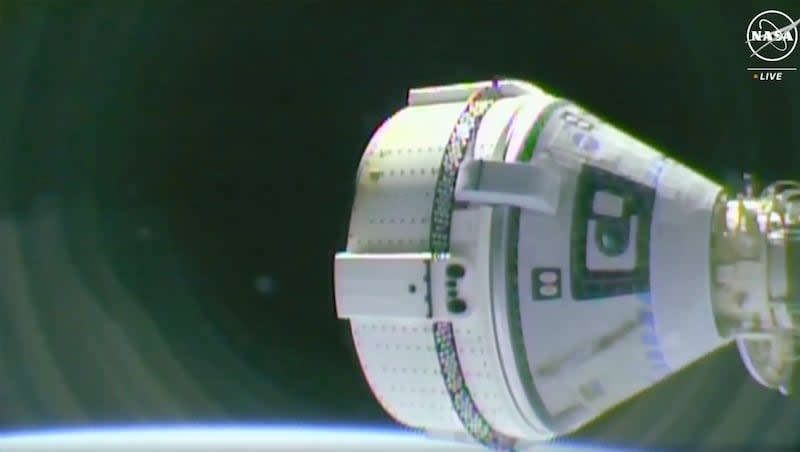Utah looking less likely as landing site for Starliner return

Helium leaks and failures of some steering thrusters have kept Boeing’s Starliner spacecraft docked to the International Space Station longer than expected, but NASA and Boeing officials say they’re confident the problems won’t pose safety issues for the two-person crew now slated to return on June 26.
While Utah’s Dugway Proving Ground was considered a primary return landing site at the beginning of the mission, which launched from Cape Canaveral, Florida, on June 5, if Starliner sticks to its current schedule, the spacecraft will make a parachute-assisted ground landing early on the morning of June 26 at New Mexico’s White Sands Space Harbor, not far from runways built for the mothballed Space Shuttle program.
NASA and Boeing are now targeting no earlier than 8:10 p.m. MDT on Tuesday, June 25, for the undocking of the spacecraft from the ISS. For the primary undocking opportunity, NASA astronauts Butch Wilmore and Suni Williams, the first crew to fly aboard Starliner, would land about 2:51 a.m. MDT on Wednesday, June 26, at White Sands.
During a Tuesday press conference, Steve Stich, manager of NASA’s Commercial Crew Program, said five of 28 maneuvering thrusters failed to perform as expected during the Starliner’s docking procedure and engineers had identified a total of five small helium leaks, some of which were detected before the spacecraft launched. Helium is used in the capsule’s thruster firing procedure.
Stich said numerous tests have been conducted over the week-and-a-half since Starliner docked with the ISS and results indicate the helium leaks have slowed down since the spacecraft’s arrival. Also, while one thruster has been taken offline, tests have shown the four others that failed during rendezvous maneuvers now appear to be in working order. The previous target date for Starliner’s return to Earth was June 22, but Stich said the additional time allows additional testing to “make sure we’re really ready to come home.”
Space exploration as a private sector endeavor
Back in 2014, NASA announced a pair of “groundbreaking” contracts, granted to Boeing and SpaceX, aiming to bring the job of ferrying astronauts to and from the orbiting ISS, a task that was assumed by Russia’s Roscosmos following the retirement of the Space Shuttle program in 2011, back to the U.S.
Boeing’s long partnership with NASA and jumbo $4.2 billion contract, compared to SpaceX’s $2.6 billion, led many to believe early on that the legacy aircraft and aerospace company would outpace Elon Musk’s scrappy space startup and be first to the finish line in NASA’s new Commercial Crew Transportation Capability effort.
But a series of delays allowed SpaceX to leapfrog Boeing in the work to develop a new crew transport vehicle and in 2020, SpaceX’s Dragon 2 Crew Capsule became the first U.S.-launched spaceflight to carry astronauts to the ISS since the final, 13-day shuttle mission performed by Atlantis.
In May, NASA Administrator Bill Nelson said the Starliner test flight is a crucial step in NASA’s ongoing efforts to commercialize the business of space exploration, including the effort to replace the job of ferrying astronauts to the International Space Station following the retirement of the Space Shuttle program in 2011.
“This is all a part of our commercial activities,” Nelson said. “You’ve already seen commercial crew and cargo go to orbit with the Dragon and other cargo vehicles. This will give us that additional capacity because we always look for a backup.
“It’s a fixed-price contract. We share in the development costs but then the operation is a fixed-price contract. We’re doing that as we go to the moon as well.”
Boeing’s long journey to space
Boeing has had to overcome issues both within and without its Starliner program on the path to the first crewed launch earlier this month, while SpaceX has now completed nine crewed missions to the ISS with its Dragon capsule and has a 10th in progress.
An uncrewed Starliner test flight in 2019 exposed software and communications issues that combined to derail an attempt to dock with the space station and almost led to the crew ship’s destruction, per CBS News.
A second test flight in 2021 was scrubbed after engineers discovered corroded valves in the spacecraft’s propulsion system, pushing the next attempt to 2022. And while that flight was a success, potential problems with Starliner’s parachute lines were revealed as well as the need to replace about a mile of electrical tape that was found to be flammable.
Along the way, Boeing has had to navigate major issues in its commercial airliner division, including the tragic 737 Max plane crashes and, more recently, production and quality control issues that were highlighted when a Boeing plane flown by Alaska Airlines lost a door plug component in the passenger cabin during a flight.

